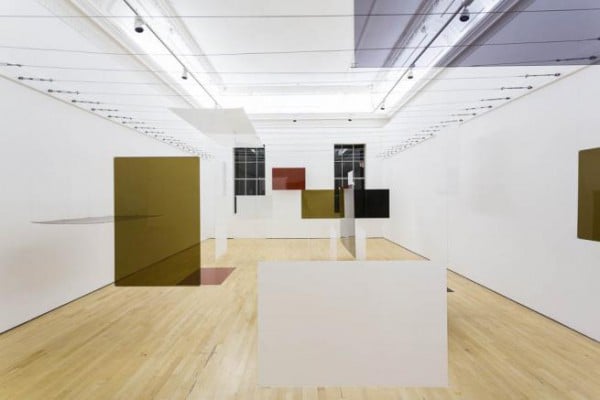Art & Exhibitions
Looking at Richard Hamilton’s an Exhibit at the ICA


Coline Milliard

The Institute of Contemporary Arts has made a come back. Led by Gregor Muir, the organization has rekindled its avant-gardist legacy through a series of high-profile collaborations, most recently with the Tate Modern. As the former power plant rolled out its much-anticipated Richard Hamilton retrospective earlier this month, the ICA unveiled a reconstruction of two of the artist’s early installations—Man, Machine and Motion and an Exhibit—both first shown in London at the ICA’s former Dover Street home in the 1950s.
It’s a smart move. The exhibition is tight and focused, an ideal counterpoint to the blockbuster show across the river. And shown together, the two pieces give a fascinating insight into Hamilton’s creative process in the early years of his career.
Exhibiting downstairs, Man, Machine and Motion is symptomatic of the artist’s interest in architecture and design. The three-dimensional piece is organized by a metal grid made of units (each four feet wide) on which hang found images depicting modes of transport pasted on Formica boards. It’s a kaleidoscopic historiography of travel technology from Leonardo da Vinci’s fantasy flying apparatus to dream-vacation diving ads. The non-hierarchical arrangement of images, plucked from a wide array of sources, is a key component of Man, Machine and Motion. This collision of cultural spheres—inherited from Dada and Surrealism—was to become a central tenet of Pop Art.
But the pictures didn’t appeal to Hamilton’s friend, fellow artist Victor Pasmore. The painter Pasmore, the story goes, felt that the work was good—except for the images. He suggested Hamilton produce another purely abstract piece, very much in line with his own Constructions of the same period. The outcome was an Exhibit (1957), currently displayed on the ICA’s first floor.
Credited as a collaborative piece between Hamilton, Pasmore, and critic Lawrence Alloway, an Exhibit is a maze of gray, white, and brown acrylic sheets hung on thin wires, and interspersed with the odd Indian red panel (a concession to Pasmore’s palette). It is a highly physical experience, one which no doubt felt radical at the time. Let’s not forget that installation art was still in its infancy in 1957; and Alan Kaprow was yet to talk about “environments.”
Hamilton had already grappled with the genre in his exhibition Growth and Form from 1951; with an Exhibit he freed himself from all representational elements. The panels both define space and stand as morsels of space themselves, each infused with its own mood. The artists in turn spur on and lose their viewers, sometimes directing their steps with a corridor-like arrangement, sometimes stopping them dead in their tracks with a completely see-through panel. an Exhibit pursued the Modernist ideal of art as accessible—“penetrable” as Hélio Oiticica would later come to say in Brazil. Today it appears prescient: hinting at the fascination with contemporary materials shared by both Pop Art and Minimalism, as well as experimenting with a phenomenological approach to the artwork-beholder relationship, which was to become so prevalent in the years that followed.
In conjunction with the ICA’s offering, the Tate Modern is exhibiting the reconstitution of four installations, including Growth and Form, restaged for the very first time. Hamilton himself wasn’t keen on the inclusion of these pieces. In the exhibition catalogue, co-curator Paul Schimmel explains how challenging it was to convince the artist that it was “worth giving up valuable gallery space” for them. Victoria Walsh, who spearheaded the reconstruction of Growth and Form, writes that Hamilton refused to “advise directly on the reconstruction,” although he encouraged the curators to unearth his original procedures. This is somewhat surprising, as the artist had himself been involved in building a famous reproduction: a version of Marcel Duchamp’s Large Glass (1915–1923), reconstructed with the older artist’s approval for a Duchamp retrospective at Tate Gallery in 1966, curated by Hamilton.
But for all his reluctance when it came to his own retrospective, Hamilton understood that a replica could create much more than an ersatz aesthetic experience, and even transcend the idea of original. His Large Glass belongs to Duchamp’s oeuvre. The younger Hamilton fully internalized the message of his elusive mentor, claiming it was thanks to him that he realized “art was all about thinking.”
When carefully made, today’s museum replicas are steeped in this conceptual tradition. They reinvigorate art history, enrich the artwork by investing it with new layers of meaning, and open up spaces for reinterpretation (perhaps inaccurate), which all becomes part and parcel of the artwork. At the ICA, an Exhibit and Man, Machine and Motion also remind us of the role this institution played in the lives of some of Britain’s most influential Contemporary artists, anchoring them in its past to secure its own future.